The Lunar New Year, also known as Tết in Vietnam, is a vibrant annual celebration observed by millions of people across Asia and around the world. Rooted in rich cultural and historical traditions, this festival marks the beginning of a new year on the lunar calendar, symbolizing new beginnings. It’s a time for family reunions, feasting on traditional foods, and celebrating through rituals that bring good fortune and prosperity.
Lunar New Year also has a significant economic impact in the countries where it’s celebrated; China, for example, experienced a travel surge in 2023 for Lunar New Year. When it comes to remittances, there is an increase in financial transactions during this time, as many people send money to their families and loved ones. This trend reflects the strong ties that families keep with their loved ones and traditions during Lunar New Year, no matter where they are in the world—and the vastness of the Asian diaspora, who maintain cultural and economic ties to their homeland.
To discover more about the diverse cultural traditions of Lunar New Year, four Remitlians shared how their families celebrate.
Evelyne Kuo, Senior Content Associate, Brand
For Evelyne, who grew up in Taiwan, the Lunar New Year begins with a New Year’s Eve dinner, a tradition rooted deeply in her childhood experiences in Taiwan. She remembers lavish dinner tables spread with an array of dishes, rich in flavor and meaning. “Fish in Mandarin sounds the same as abundance. So we usually have one fish dish for abundance in the coming year. We’ll also have meat to symbolize having a good life because in ancient times, meat was scarce,” Evelyne explains. Vegetables are equally significant like bao sin mustard greens (macrobiotics), which represent longevity.
The festivities in Evelyne’s family extend beyond dinner, with lively conversations followed by setting off fireworks at midnight. The celebrations span 15 days, filled with visits to relatives and friends. The last day is the Lantern Festival, marked by writing wishes on lanterns and releasing them into the sky, symbolizing the ushering in of good fortune. Evelyne’s family also comes together to enjoy sweet treats during the last day. “We usually eat sweet glutinous rice balls, with a sesame or peanut filling inside,” Evelyne shares. “They’re round, to symbolize completeness,” reflecting the end of the Lunar New Year.

A symbol of prosperity and luck
Red symbolizes luck and prosperity for many countries that celebrate Lunar New Year. Red envelopes filled with money are traditionally given by elders to younger family members as a gesture of good luck, and it’s common to write wishes on long scrolls of red paper. “People write lucky Chinese words and put them next to their door,” Evelyne says.
Evelyne’s family also embraces the tradition of wearing red. “We always have to wear new clothes on the first day of a new year,” she recalls fondly. “Before the New Year, my parents would take me to the mall to buy new red clothing, and we’d go over to our grandparents’ houses to wish them well.”
The festive atmosphere is palpable as the New Year approaches, with businesses partaking in the cheer. “’Restaurants and grocery stores will give out free red letters for people to put on their doors with lucky words,” she adds.
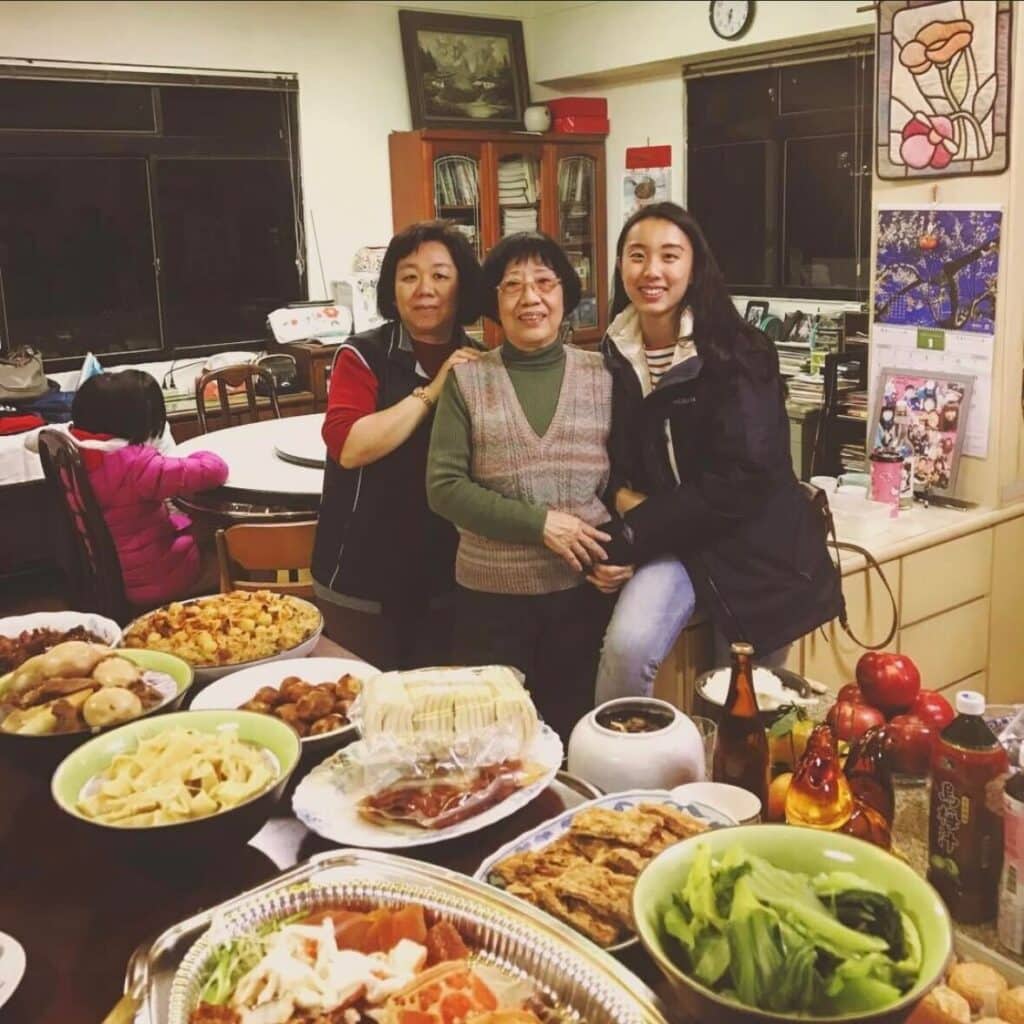
For Evelyne, the most heartwarming memories were those spent with her grandparents, who played a significant role in her upbringing. “One of my favorite memories is the New Year’s Eve dinner where I got to spend time with my dad’s parents because they helped raise me as a kid,” she shares. Her grandmother, an elementary school teacher, was a guiding force in her life. “I loved watching TV and releasing the fireworks together; it was a special bonding moment for me.”
Creating new traditions
Even though Evelyne now lives in the U.S., she continues to honor Lunar New Year traditions while embracing new ones. “My entire family is still back home in Taiwan, so they stick to all the traditions,” she explains. “I sometimes hang out with my Chinese friends, and we make dumplings together, and give each other red envelopes,” she shares. Despite the distance, Evelyne finds ways to keep the spirit of the festival alive.
Ben Kim, Senior Manager, Finance Enablement
Ben immigrated to the U.S. from South Korea when he was three, but maintains a strong connection to Lunar New Year traditions. “Lunar New Year’s always signifies a new beginning and a fresh start, and we do that by eating a lot of traditional foods,” Ben says. These traditional foods, integral to the celebration, include an array of Korean dishes such as tteokguk (rice cake soup), nokdujeon (mung bean pancakes), bulgogi (Korean beef barbecue), kimchi dumplings, and japchae, a flavorful stir-fry with glass noodles.
Food plays a central part in the festivities, and it also serves as a conduit to strengthen family bonds. Some of Ben’s most treasured memories revolve around preparing dishes, particularly tteokguk, with his family. “We would make dumplings as part of the rice cake soup, and my mom and grandmother would make the stuffing by hand,” he recalls. “We would fill the dumplings by hand, and how pretty you made the dumplings was also a kind of blessing, almost like reading tea leaves. If you made very pretty dumplings, it meant that you had good fortune coming to you in the future.”
Honor, reverence, and gratitude
A key aspect of Lunar New Year celebrations involves paying homage to elders, a practice deeply rooted in respect and gratitude across generations. “Honoring the elders who’ve passed has ties to the Buddhist traditions,” he explains. This act of remembrance is not just symbolic but deeply personal. “We used to honor my grandfather who had passed by making a shrine with a picture of him,” he says. “We’d light some incense, and bow to honor everything that he’s done for us to have the life that we have today.”
In addition to commemorating those who have passed, Ben also emphasizes the importance of honoring living family members. “Bowing is a form of showing respect to our elders, so we bow and ask for their blessing, support, and guidance for the upcoming year,” he says. Hanboks, a style of traditional Korean clothing that dates back over 2,000 years, are worn during this time.
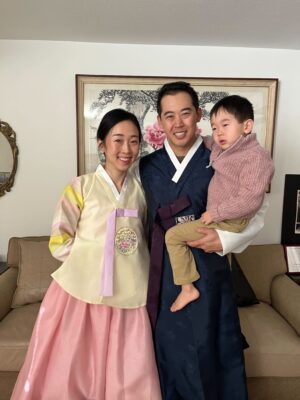
The Lunar New Year is also a time when elders give cash gifts, but for Ben, the value of these interactions goes beyond money. “It’s a time to ask for guidance and blessings, and also where the elders can talk to us about things they’ve noticed we’ve done well or may be struggling with,” he shares. The tradition is something Ben cherishes deeply and aspires to pass down through his family in the future. “I hope that my wife and I will continue to embrace this tradition so that when my son grows up, he embraces it too.”
Lunar New Year also serves as a period of introspection and commemoration for Ben and his family, and a chance to contemplate their personal and collective aspirations. “Around Lunar New Year and other significant events throughout the year, my wife and I like to reflect and talk about our hopes and wishes for the future, and all the ways that we can support each other more,” Ben shares. This practice has evolved into a cherished family tradition for everyone in the family, regardless of age. “My son is four years old, and he’s got input on what he wants to focus on,” Ben says about their young son’s participation. “It’s something that we do as a family.”
Anna Zhang, Product Marketing Manager
For Anna, who moved from Tianjin, China to the U.S. during her high school years, the Lunar New Year has always been deeply associated with family. “Each year, when I was younger, we’d pick one set of grandparent’s house to go to,” she says. “We’d switch every year to make sure that we spent Lunar New Year with both sides.”
One of her most cherished memories is of her maternal grandparents and family coming together to make dumplings throughout the day. “I grew up with my grandmother, and I really enjoyed spending time with my grandparents, cousins, aunts, and uncles, because they made the day so fulfilling when we were kids. Each year, they would prepare something just for us to eat, and they would make dumplings with all these intricate designs while we played,” Anna fondly recalls. The cultural significance of watching the Spring Festival Gala, especially in the north of the country where Anna is from, was also a major part of their celebration. “My cousin and I would usually fall asleep, but our family would wake us up at midnight so we wouldn’t miss the fireworks. It was such a good time; after the fireworks, we’d eat and talk, and my family didn’t leave until 2 or 3 a.m.”
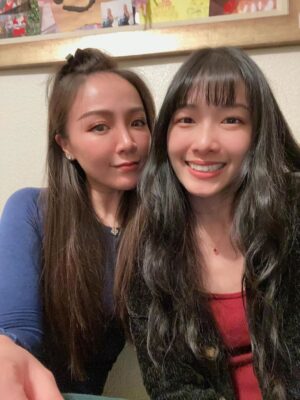
Now that Anna resides in the States, she strives to recreate those cherished moments, especially when her parents visit from New York, where they’ll be joining her this year. The preparations for the day typically involve shopping for gifts and ensuring the house is immaculate for the New Year. “On New Year’s Eve, we make sure the house is very clean—we clean to remove any bad spirits in the house and wear something red,” she explains.
Dinner is the centerpiece of the celebrations, providing an opportunity for her family to come together and enjoy each other’s company. “Dinner is a really big part of the day. My husband plans the dishes we want to prepare weeks in advance,” she states. The preparation for this special meal starts around 3 p.m. and extends well into the night, capturing the essence of the Lunar New Year: familial bonds, tradition, and the joy of togetherness. “We start to eat dinner around six, and it’s a long dinner—we’re talking, taking photos, and there’s a lot of reheating dishes.”
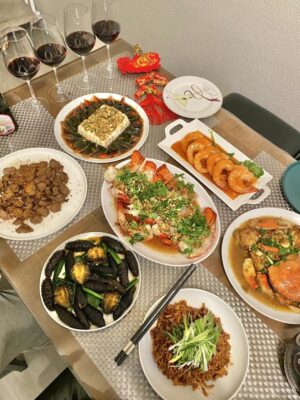
A very special New Year
2024, the Year of the Dragon, holds a special place in the Lunar New Year cycle. Unlike other zodiac animals like the rat, ox, dog, pig, or rabbit, which are based on real-life creatures, the Dragon stands out as a mythical creature, similar to the role of unicorns in Western culture. “The dragon is a really special zodiac sign and it’s also the symbol of China,” Anna says.
The dragon’s unique status as a mysterious animal and its deep-rooted symbolism in Chinese culture contribute to the anticipation and reverence for the Year of the Dragon. “The dragon is used a lot in China to symbolize power, so if someone wants to get engaged or married they’ll try to plan it for the Year of the Dragon because it’s such a memorable year,” Anna says.
Hanh Huynh, Senior Marketing Manager
Tết, the Vietnamese Lunar New Year, is not just a holiday; it’s the most significant celebration for Vietnamese people, both in Vietnam and abroad. For Hanh, Tết involves extensive preparations one to two months before. “During the Tết week, people normally go back to their hometown where their parents live, start getting the house ready, and buy a bunch of decorations in advance,” she says.
The preparations for Tết are regional and symbolic, involving everything from home decor to special clothing. Hanh is from southern Vietnam, where yellow apricot blossoms are used to decorate for the New Year. Ao dai, Vietnam’s national dress, is also worn during the New Year. “Ao dai is a long, traditional, beautiful dress that we wear on the first day of New Year and during the first week when you visit friends and family,” she says. “We’ll start to buy some new ao dai, or make something new to wear.”
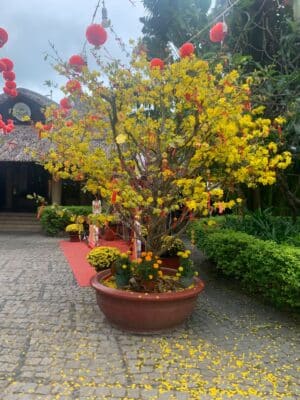
Food also plays a crucial role in the weeks leading up to Tết. “We start to make the vegetable pickles which often include carrots, onions, and radishes that we’ll eat during the New Year,” Hanh says. One of the dishes her family makes is thịt kho, slowly braised and caramelized pork belly with eggs. It’s served with bánh Tết, a cylindrical rice cake made in Southern and Central Vietnam. In addition to savory dishes, sweet treats are a significant part of the Tết preparations, with candied and dried fruits symbolizing sweetness and prosperity for the New Year. “We’ll also make candied ginger, kumquat, sweet potatoes, and more,” Hanh says.
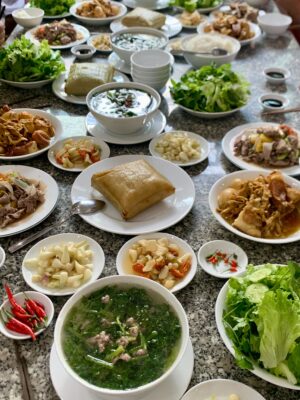
The first days of Tết are dedicated to visiting family, especially grandparents, and extending good wishes for the year ahead. “On the day of the New Year, we normally have the family meal and we always visit grandparents on the first day and give out lucky money to younger family members in red envelopes,” she says.
The reverence shown to ancestors is a pivotal part of Tết, with dedicated altars and offerings in every Vietnamese home. “We remember our ancestors and we do a ceremony honoring them, offering flowers and traditional homemade foods for luck in the New Year,” she says. “Every Vietnamese home will have a dedicated corner in the house for our ancestors.” In addition to family visits and ceremonial traditions, the first week of Tết is filled with various activities, from cooking and hosting friends to visiting pagodas and engaging in sightseeing.
Connecting with home
“Being there to celebrate in person is one tradition I would love to create for myself,” she says, reflecting on how moving away has impacted how she celebrates Tết. “I moved to the U.S. for my higher education and work, so there’s been a few years I’ve missed not being with my family to celebrate. It’s very important to be there in person for me.”
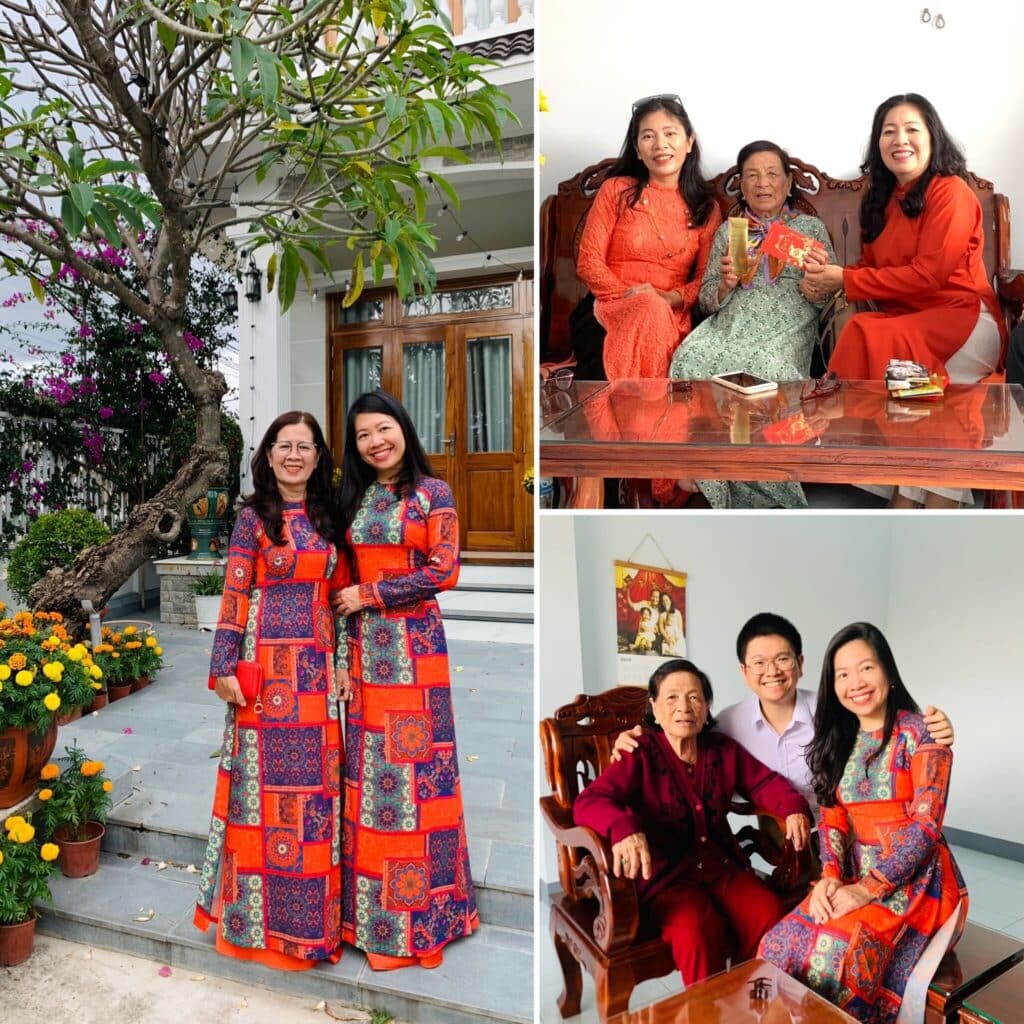
Despite her absence, she has found ways to maintain her connection to traditions. “I send some gifts to my mom and grandma, and I’ll surprise them with a tailor-made ao dai,” she says. “We FaceTime a lot, and I sometimes send money with Remitly.” Hanh is one of the many Vietnamese immigrants sending money back home. Last year, the World Bank reported that Vietnamese remittances would hit $14 billion; during this Lunar New Year, remittances are forecasted to increase sharply.
From nostalgic childhood memories to creating new customs living abroad, the stories highlight the significance of the Lunar New Year and how it transcends cultures and geographies. For millions worldwide, the Lunar New Year symbolizes a strengthening of cultural identities, family unity, and the optimism of new beginnings — regardless of where it’s celebrated.
